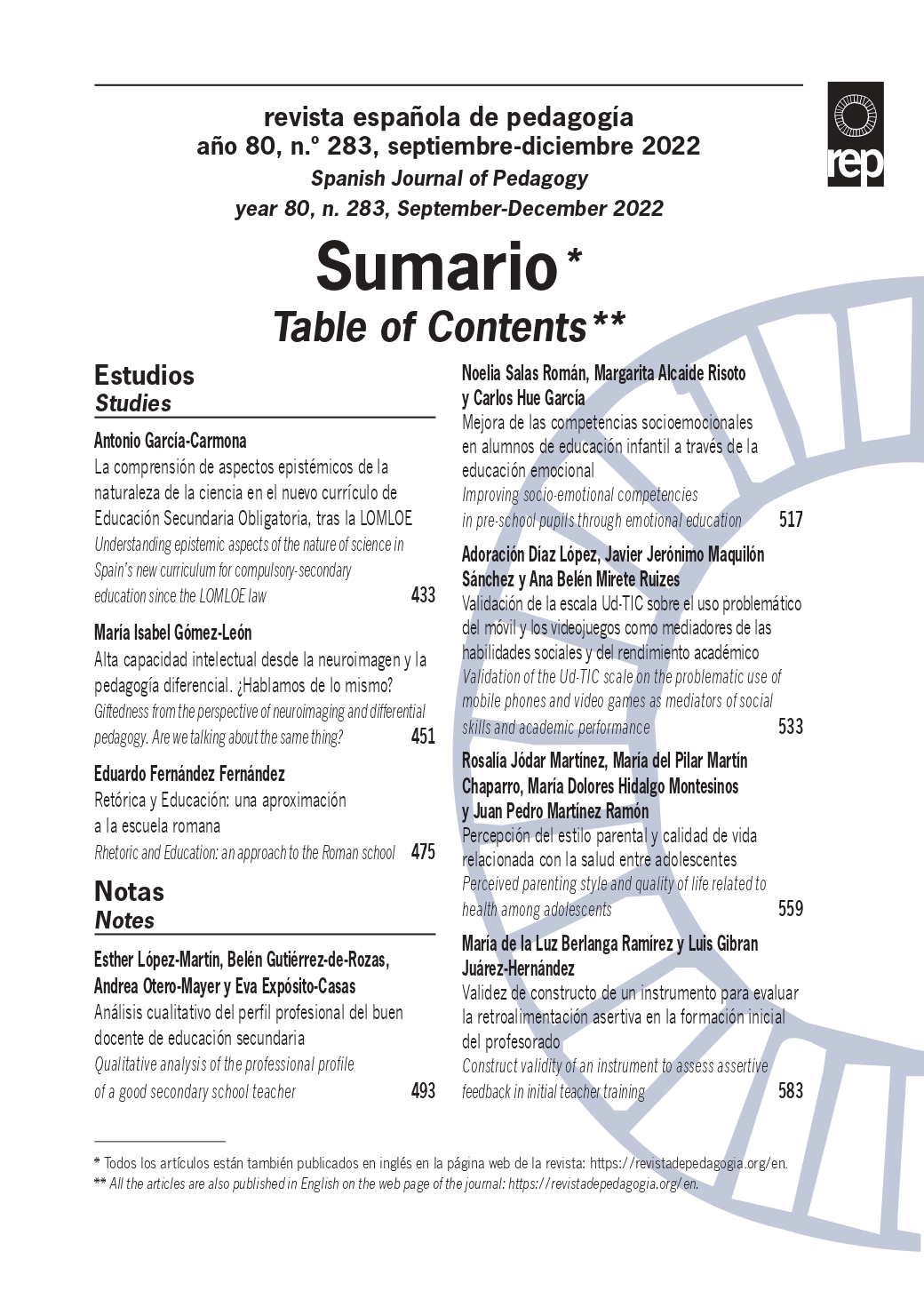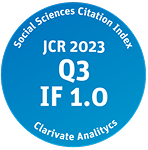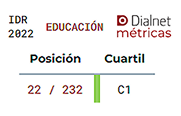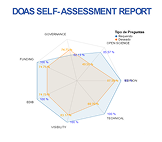Giftedness from the perspective of neuroimaging and differential pedagogy. Are we talking about the same thing?
DOI:
https://doi.org/10.22550/REP80-3-2022-02Keywords:
giftedness, intelligence, differential pedagogy, neuroimaging, assessment, identification, intelligence quotientAbstract
Advances in neuroimaging techniques have significantly enhanced our ability to study differences in cognitive efficiency in children and adolescents. However, these studies have traditionally used intelligence quotient (IQ) as the sole measure of cognitive ability. Talent development experts are increasingly drawing attention to the major limitations of exclusively using this measure to identify the variables associated with giftedness, in terms of the validity of the construct they intend to measure and in respect of the measurement’s reliability and stability. The aim of this study is to analyse whether the construct of intelligence on which recent neuroimaging studies are based, the type of instrument used to quantify giftedness and the corresponding neurobiological results are consistent with the advances made by differential pedagogy in respect of the multidimensional construct of intelligence. To this end, a systematic review both of neuroimaging research that seeks to explain the neural correlates of giftedness in children and adolescents, on the one hand, and of research focussing more prominently on the field of giftedness development, on the other, has been carried out. The findings suggest that brain networks and dynamics associated with creativity and motivation may have a bearing on cognitive performance variability. However, as the majority of neuroimaging studies continue to use IQ as the sole measure of intellectual ability, most of the data produced by these studies cannot be generalised for the purpose of determining what differential pedagogy experts refer to as “giftedness”.
Downloads
References
American Educational Research Association, American Psychological Association y National Council on Measurement and Education (2014). Standards for educational and psychological testing. American Educational Research Association.
Aubry, A. y Bourdin, B. (2018). Short forms of Wechsler scales assessing the intellectually gifted children using simulation data [Formas cortas de las escalas Wechsler que evalúan a los niños superdotados intelectualmente utilizando datos de simulación]. Frontiers in psychology, 9, 830. https://doi.org/10.3389/fpsyg.2018.00830
Barbey, A. K. (2018). Network Neuroscience Theory of human intelligence [Teoría de la neurociencia en red sobre la inteligencia humana]. Trends in cognitive sciences, 22 (1), 8-20. https://doi.org/10.1016/j.tics.2017.10.001
Bathelt, J., Johnson, A., Zhang, M. y Astle, D. E. (2019). The cingulum as marker of individual differences in neurocognitive development [El cíngulo como marcador de las diferencias individuales en el desarrollo neurocognitivo]. Scientific reports, 9 (1), 2281. https://doi.org/10.1038/s41598-019-38894-z
Burgaleta, M., Johnson, W., Waber, D. P., Colom, R. y Karama, S. (2014a). Cognitive ability changes and dynamics of cortical thickness development in healthy children and adolescents [Cambios en la capacidad cognitiva y dinámica del desarrollo del grosor cortical en niños y adolescentes sanos]. NeuroImage, 84, 810-819. https://doi.org/10.1016/j.neuroimage.2013.09.038
Byington E. y Felps W. (2010). Why do IQ scores predict job performance? An alternative, sociological explanation [¿Por qué las puntuaciones de CI predicen el rendimiento laboral? Una explicación alternativa y sociológica]. Research in Organizational Behavior, 30 (C), 175-202. https://doi.org/10.1016/j.riob.2010.08.003
Castelló, T.A. (2008). Bases intelectuales de la excepcionalidad, un esquema integrador. revista española de pedagogía, 240, 203-220.
Clayden, J. D., Jentschke, S., Muñoz, M., Cooper, J. M., Chadwick, M. J., Banks, T., Clark, C. A. y Vargha-Khadem, F. (2012). Normative development of white matter tracts: similarities and differences in relation to age, gender, and intelligence [Desarrollo normativo de los tractos de materia blanca: similitudes y diferencias en relación con la edad, el sexo y la inteligencia]. Cerebral cortex, 22 (8), 1738-1747. https://doi.org/10.1093/cercor/bhr243
Colom R., Abad F. J., García L. F. y Juan-Espinosa, M. (2002). Educación, coeficiente intelectual de escala completa de Wechsler y g. Intelligence, 30 (5), 449-462. https://doi.org/10.1016/S0160-2896(02)00122-8
Fjell, A. M., Westlye, L. T., Amlien, I., Tamnes, C. K., Grydeland, H., Engvig, A., Espeseth, T., Reinvang, I., Lundervold, A. J., Lundervold, A. y Walhovd, K. B. (2015). High-expanding cortical regions in human development and evolution are related to higher intellectual abilities [Regiones corticales de alta expansión en el desarrollo y la evolución de los seres humanos se relacionan con mayores capacidades intelectuales]. Cerebral cortex, 25 (1), 26–34. https://doi.org/10.1093/cercor/bht201
Gagné, F. (2015). From genes to talent: the DMGT/CMTD perspective [De los genes al talento: la perspectiva del DMGT/CMTD]. Revista de Educación, 368, 12-37. https://doi.org/10.4438/1988-592X-RE-2015-368-289
Gignac, G. E. y Bates T. C. (2017). Brain volume and intelligence: The moderating role of intelligence measurement quality [Volumen cerebral e inteligencia: el papel moderador de la calidad de la medición de la inteligencia]. Intelligence, 64, 18- 29. https://doi.org/10.1016/j.intell.2017.06.004
Gómez-León, M. I (2019). Psicobiología de las altas capacidades. Una revisión actualizada. Psiquiatría biológica, 26 (3), 105-112 https://doi.org/10.1016/j.psiq.2019.09.001
Gómez-León, M. I. (2020a). La psicobiología de la motivación en el desarrollo de las altas capacidades intelectuales. Revisión bibliográfica. Psiquiatría biológica, 27 (2), 47-53. https://doi.org/10.1016/j.psiq.2020.01.003
Gómez-León, M. I. (2020b). Bases psicobiológicas de la creatividad en los niños con altas capacidades. Psiquiatría biológica, 27 (1), 28-33. https://doi.org/10.1016/j.psiq.2020.01.004
Gómez-León, M. I. (2020c). Desarrollo de la alta capacidad durante la infancia temprana. Papeles del Psicólogo, 41 (2), 147-158. https://doi.org/10.23923/pap.psicol2020.2930
Gómez-León, M. I. (2020d). Psicobiología de la alta capacidad intelectual y el trastorno por déficit de atención con hiperactividad. Diagnóstico diferencial. Psiquiatría biológica, 27 (3), 96-104. https://doi.org/10.1016/j.psiq.2020.06.003
Goriounova, N. A. y Mansvelder, H. D. (2019). Genes, cells and brain areas of intelligence. Frontiers in human neuroscience, 13, 44. https://doi.org/10.3389/fnhum.2019.00044
Jiménez, J. E., Artiles, C., Rodríguez, C., García, E., Camacho, J. y Moraes, J. (2008). Creatividad e inteligencia: ¿dos hermanas gemelas inseparables? revista española de pedagogía, 240, 261-282.
Karama, S., Colom, R., Johnson, W., Deary, I. J., Haier, R., Waber, D. P., Lepage, C., Ganjavi, H., Jung, R., Evans, A. C. y Brain Development Cooperative Group (2011). Cortical thickness correlates of specific cognitive performance accounted for by the general factor of intelligence in healthy children aged 6 to 18 [Correlaciones del grosor cortical del rendimiento cognitivo específico contabilizado por el factor general de la inteligencia en niños sanos de 6 a 18 años]. NeuroImage, 55 (4), 1443-1453. https://doi.org/10.1016/j.neuroimage.2011.01.016
Kenett, Y. N., Medaglia, J. D., Beaty, R. E., Chen, Q., Betzel, R. F., Thompson-Schill, S. L. y Qiu, J. (2018). Driving the brain towards creativity and intelligence: A network control theory analysis [Dirigiendo el cerebro hacia la creatividad y la inteligencia: un análisis de la teoría de control de redes]. Neuropsychologia, 118 (Pt A), 79-90. https://doi.org/10.1016/j.neuropsychologia.2018.01.001
Khundrakpam, B. S., Lewis, J. D., Reid, A., Karama, S., Zhao, L., Chouinard-Decorte, F., Evans, A. C. y Brain Development Cooperative Group (2017). Imaging structural covariance in the development of intelligence [La imagen de la covarianza estructural en el desarrollo de la inteligencia]. NeuroImage, 144, 227-240. https://doi.org/10.1016/j.neuroimage.2016.08.041
Kim, D. J., Davis, E. P., Sandman, C. A., Sporns, O., O’Donnell, B. F., Buss, C. y Hetrick, W. P. (2016). Children’s intellectual ability is associated with structural network integrity [La capacidad intelectual de los niños está asociada a la integridad estructural de la red]. NeuroImage, 124, 550-556. https://doi.org/10.1016/j.neuroimage.2015.09.012
Kocevar, G., Suprano, I., Stamile, C., Hannoun, S., Fourneret, P., Revol, O., Nusbaum, F. y Sappey-Marinier, D. (2019). Brain structural connectivity correlates with fluid intelligence in children: A DTI graph analysis [La conectividad estructural del cerebro se correlaciona con la inteligencia fluida en los niños: un análisis gráfico DTI]. Intelligence, 72, 67-75. https://doi.org/10.1016/j.intell.2018.12.003
Koenis, M., Brouwer, R. M., Swagerman, S. C., van Soelen, I., Boomsma, D. I. y Hulshoff Pol, H. E. (2018). Association between structural brain network efficiency and intelligence increases during adolescence [La asociación entre la eficiencia estructural de la red cerebral y la inteligencia aumenta durante la adolescencia]. Human brain mapping, 39 (2), 822-836. https://doi.org/10.1002/hbm.23885
Lange, N., Froimowitz, M. P., Bigler, E. D., Lainhart, J. E. y Brain Development Cooperative Group (2010). Associations between IQ, total and regional brain volumes, and demography in a large normative sample of healthy children and adolescents. Developmental neuropsychology, 35 (3), 296-317. https://doi.org/10.1080/87565641003696833
Langeslag, S. J., Schmidt, M., Ghassabian, A., Jaddoe, V. W., Hofman, A., van der Lugt, A., Verhulst, F. C., Tiemeier, H. y White, T. J. (2013). Functional connectivity between parietal and frontal brain regions and intelligence in young children: the Generation R study [Conectividad funcional entre regiones cerebrales parietales y frontales e inteligencia en niños pequeños: el estudio de la Generación R]. Human brain mapping, 34 (12), 3299-3307. https://doi.org/10.1002/hbm.22143
MacDonald, P. A., Ganjavi, H., Collins, D. L., Evans, A. C. y Karama, S. (2014). Investigating the relation between striatal volume and IQ [Investigación de la relación entre el volumen estriatal y el CI]. Brain imaging and behavior, 8 (1), 52- 59. https://doi.org/10.1007/s11682-013-9242-3
Margolis, A., Bansal, R., Hao, X., Algermissen, M., Erickson, C., Klahr, K. W., Naglieri, J. A. y Peterson, B. S. (2013). Using IQ discrepancy scores to examine the neural correlates of specific cognitive abilities. The Journal of Neuroscience: The Official Journal of the Society for Neuroscience, 33 (35), 14135-14145. https://doi.org/10.1523/JNEUROSCI.0775-13.2013
Menary, K., Collins, P. F., Porter, J. N., Muetzel, R., Olson, E. A., Kumar, V., Steinbach, M., Lim, K. O. y Luciana, M. (2013). Associations between cortical thickness and general intelligence in children, adolescents and young adults [Asociaciones entre el grosor cortical y la inteligencia general en niños, adolescentes y adultos jóvenes]. Intelligence, 41 (5), 597-606. https://doi.org/10.1016/j.intell.2013.07.010
Navas-Sánchez, F. J., Alemán-Gómez, Y., Sánchez-Gonzalez, J., Guzmán-De-Villoria, J. A., Franco, C., Robles, O., Arango, C. y Desco, M. (2014). White matter microstructure correlates of mathematical giftedness and intelligence quotient [Correlación de la microestructura de la materia blanca con la superdotación matemática y el cociente intelectual]. Human brain mapping, 35 (6), 2619-2631. https://doi.org/10.1002/hbm.22355
Nolla, G. C., Pareja, E. M. D., Tudela, J. M. O. y de la Rosa, A. L. (2017). Análisis y valoración de la situación actual del alumnado con altas capacidades en España. Revista de Educación Inclusiva, 5 (2), 129-140. https://revistaeducacioninclusiva.es/index.php/REI/article/view/238/232
Nusbaum, F., Hannoun, S., Kocevar, G., Stamile, C., Fourneret, P., Revol, O. y Sappey-Marinier, D. (2017). Hemispheric differences in white matter microstructure between two profiles of children with high intelligence quotient vs. controls: A tract-based spatial statistics study [Diferencias hemisféricas en la microestructura de la materia blanca entre dos perfiles de niños con alto coeficiente intelectual frente a los controles: un estudio estadístico espacial basado en tractos]. Frontiers in neuroscience, 11, 173. https://doi.org/10.3389/fnins.2017.00173
Ouzzani, M., Hammady, H., Fedorowicz, Z. y Elmagarmid, A. (2016). Rayyan — a web and mobile app for systematic reviews [Rayyan - una aplicación web y móvil para revisiones sistemáticas]. Systematic Reviews, 5, 210. https://doi.org/10.1186/s13643-016-0384-4
Pfeiffer, S. I. (2020). Giftedness and talent development in children and youth [Desarrollo de altas capacidades y talentos en niños y jóvenes]. En P. Ward, J. M. Schraagen, J. Gore y E. M. Roth (Eds.), The Oxford Handbook of Expertise (pp. 103-127). Oxford University Press.
Renzulli, J. S. (2021). El papel del profesor en el desarrollo de habilidades cognitivas complejas en personas jóvenes. revista española de pedagogía, 79 (278), 13-32. https://doi.org/10.22550/REP79-1-2021-01
Sastre-Riba, S. y Castelló, A. (2017). Fiabilidad y estabilidad en el diagnóstico de la alta capacidad intelectual. Revista de Neurología, 64 (1), 51- 58. https://doi.org/10.33588/rn.64S01.2017028
Sastre-Riba, S. y Ortiz, T. (2018). Neurofuncionalidad ejecutiva: estudio comparativo en las altas capacidades. Revista de Neurología, 66 (1), 51- 56. https://doi.org/10.33588/rn.66S01.2018026
Schnack, H. G., van Haren, N. E., Brouwer, R. M., Evans, A., Durston, S., Boomsma, D. I., Kahn, R. S. y Hulshoff Pol, H. E. (2015). Changes in thickness and surface area of the human cortex and their relationship with intelligence [Los cambios en el grosor y la superficie del córtex humano y su relación con la inteligencia]. Cerebral cortex, 25 (6), 1608-1617. https://doi.org/10.1093/cercor/bht357
Silverman, L. K. y Gilman, B. J. (2020). Best practices in gifted identification and assessment: Lessons from the WISC-V [Mejores prácticas en la identificación y evaluación de superdotados: lecciones del WISC-V]. Psychology in the Schools, 57 (10), 1569-1581. https://doi.org/10.1002/pits.22361
Solé-Casals, J., Serra-Grabulosa, J. M., Romero-Garcia, R., Vilaseca, G., Adan, A., Vilaró, N., Bargalló, N. y Bullmore, E. T. (2019). Structural brain network of gifted children has a more integrated and versatile topology [La red estructural del cerebro de los niños superdotados tiene una topología más integrada y versátil]. Brain structure & function, 224 (7), 2373-2383. https://doi.org/10.1007/s00429-019-01914-9
Sripada, C., Angstadt, M., Taxali, A., Clark, D. A., Greathouse, T., Rutherford, S., Dickens, J. R., Shedden, K., Gard, A. M., Hyde, L. W., Weigard, A. y Heitzeg, M. (2021). Brain-wide functional connectivity patterns support general cognitive ability and mediate effects of socioeconomic status in youth [Los patrones de conectividad funcional de todo el cerebro apoyan la capacidad cognitiva general y median los efectos del estatus socioeconómico en los jóvenes]. Translational psychiatry, 11 (1), 571. https://doi.org/10.1038/s41398-021-01704-0
Sternberg, R. J. (2012). Inteligencia. Diálogos en neurociencia clínica, 14 (1), 19-27. https://doi.org/10.31887/DCNS.2012.14.1/rsternberg
Sternberg, R. J. y O’Hara, L. (2005). Creatividad e inteligencia. CIC. Cuadernos de Información y Comunicación, 10, 113-149. https://www.redalyc.org/articulo.oa?id=93501006
Sugiarti, R., Suhariadi, F. y Erlangga, E. (2018). The chance of gifted intelligent students’ success in career [La posibilidad de que los estudiantes inteligentes superdotados tengan éxito en su carrera]. Indian Journal of Public Health Research and Development, 9 (9), 277. https://doi.org/10.5958/0976-5506.2018.01009.4
Suprano, I., Delon-Martin, C., Kocevar, G., Stamile, C., Hannoun, S., Achard, S., Badhwar, A., Fourneret, P., Revol, O., Nusbaum, F. y Sappey-Marinier, D. (2019). Topological modification of brain networks organization in children with high intelligence quotient: A resting-state fmri study [Modificación topológica de la organización de las redes cerebrales en niños con alto coeficiente intelectual: un estudio de RMF en estado de reposo]. Frontiers in human neuroscience, 13, 241. https://doi.org/10.3389/fnhum.2019.00241
Tamnes, C. K., Fjell, A. M., Østby, Y., Westlye, L. T., Due-Tønnessen, P., Bjørnerud, A. y Walhovd, K. B. (2011). The brain dynamics of intellectual development: waxing and waning white and gray matter [La dinámica cerebral del desarrollo intelectual: aumento y disminución de la materia blanca y gris]. Neuropsychologia, 49 (13), 3605-3611. https://doi.org/10.1016/j.neuropsychologia.2011.09.012
Tourón, J. (2020). Las altas capacidades en el sistema educativo español: reflexiones sobre el concepto y la identificación. Revista de Investigación Educativa, 38 (1), 15-32.
Turkheimer, E., Haley, A., Waldron, M., D’Onofrio, B. y Gottesman, I. I. (2003). Socioeconomic status modifies heritability of IQ in young children. Psychological science, 14 (6), 623-628. https://doi.org/10.1046/j.0956-7976.2003.psci_1475.x
Waber, D. P., Forbes, P. W., Almli, C. R., Blood, E. A. y Brain Development Cooperative Group (2012). Four-year longitudinal performance of a population-based sample of healthy children on a neuropsychological battery: The NIH MRI study of normal brain development [Rendimiento longitudinal de cuatro años de una muestra poblacional de niños sanos en una batería neuropsicológica: el estudio de resonancia magnética del NIH sobre el desarrollo normal del cerebro]. Journal of the International Neuropsychological Society: JINS, 18 (2), 179-190. https://doi.org/10.1017/S1355617711001536
Wang, L., Wee, C. Y., Suk, H. I., Tang, X. y Shen, D. (2015). MRI-based intelligence quotient (IQ) estimation with sparse learning [Estimación del cociente intelectual (CI) mediante resonancia magnética con aprendizaje disperse]. PloS one, 10 (3), e0117295. https://doi.org/10.1371/journal.pone.0117295
Wechsler, D. (1943). Non-intellective factors in general intelligence [Factores no intelectuales de la inteligencia general]. Journal of Abnormal and Social Psychology, 38, 101-103. https://doi.org/10.1037/h0060613
Westerhausen, R., Friesen, C. M., Rohani, D. A., Krogsrud, S. K., Tamnes, C. K., Skranes, J. S., Håberg, A. K., Fjell, A. M. y Walhovd, K. B. (2018). The corpus callosum as anatomical marker of intelligence? A critical examination in a large-scale developmental study [¿El cuerpo calloso como marcador anatómico de la inteligencia? Un examen crítico en un estudio de desarrollo a gran escala]. Brain structure & function, 223 (1), 285- 296. https://doi.org/10.1007/s00429-017-1493-0
Westlye, L. T., Walhovd, K. B., Dale, A. M., Bjørnerud, A., Due-Tønnessen, P., Engvig, A., Grydeland, H., Tamnes, C. K., Ostby, Y. y Fjell, A. M. (2010). Life-span changes of the human brain white matter: diffusion tensor imaging (DTI) and volumetry [Cambios en la materia blanca del cerebro humano a lo largo de la vida: imágenes con tensor de difusión (DTI) y volumetría]. Cerebral cortex, 20 (9), 2055-2068. https://doi.org/10.1093/cercor/bhp280
Downloads
Published
-
Abstract285
-
PDF (Español)68
-
PDF55
How to Cite
Issue
Section
License

This work is licensed under a Creative Commons Attribution-NonCommercial 4.0 International License.

